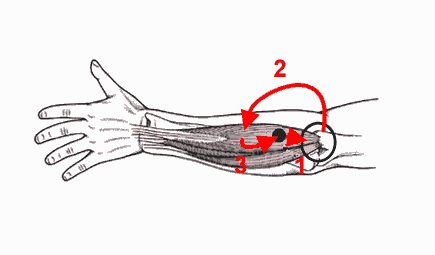
Biology of Trigger Points: Pain induced Muscle Splinting and the Persistence of Trigger Points:
A Feedback Loop out of Control.
It is well known by surgeons that a joint dislocation or a bone fracture leads
to spasm in the surrounding muscles. This is the organism's attempt to minimise
movement of the damaged part. Such spasm would most certainly cause mechanical
overload of the muscles, thus trigger points could be expected to develop in
response to joint or bone pain. Consider again the two tennis elbow case studies
in the introduction to this article. These people were experiencing pain at the
side of their elbow. It seems highly likely that the muscles in the forearms
of these people were tightening in response to that pain. Thus we have a vicious
circle (see diagram 6): Trigger points send their pain to the side of the elbow;
the pain at the side of the elbow causes forearm muscles to tighten; the tight
forearm muscles irritate their trigger point zones, which in turn refer even more
pain back to the side of the elbow. Alongside the pain, there may be an inflammatory
component as well (see prior discussion).
Diagram: The Myofascial Pain Feedback Loop -
- An active trigger point in the finger extensor muscle of the forearm sends pain
to the side of the elbow.
- The pain at the side of the elbow causes the muscles of the arm (finger extensor
muscle included) to go into spasm.
- The increased tension in the finger extensor muscle irritates the trigger point.
|
|

|
What is the solution to this out of control feedback loop? We have already seen
that a certain sort of massage (specifically, trigger point massage) can disrupt
the cycle, and thus reduce or eliminate the pain. Is there any other solution?
Yes there is. But it should be treated as a last resort. Read the next case study!
Trigger Point Case History (4): A Surgical "Cure" of Tennis Elbow
As a result of repetitive injuries from pregnancy testing and calving, Mike, a
35 year old cattle veterinarian, had severe pain at the side of his elbow. A
diagnosis of lateral humeral epicondylitis was made. Mike's caregivers did not
know about trigger point massage, and so it is not surprising that their various
treatments were ineffective. Standard physiotherapeutic stretching and strengthening
just made the pain worse. Casting was tried, but the pain upon removal of the cast
was particularly severe. As a last resort, Mike submitted to surgery. The
surgeon removed a jelly like piece (tendinosis) from the tendons that insert on
the side of the humeral epicondyle, and sutured the forearm muscles back to their
original location at the side of the elbow. Within days, Mike noted a marked
improvement in his condition. As long as he doesn't overdo it, tennis elbow is no
longer a problem for Mike.
The Myofascial pain interpretation of this surgical cure - A significant source
of Mike's tennis elbow pain was removed with the excision of the diseased tendinotic
tissue and its associated nerve endings, and thus the pain feedback loop was
de-activated. With no elbow pain to cause tightening of the forearm muscles,
Mike's trigger points were able to relax and de-activate.

Return to top...
Biology of trigger points: pain induced muscle splinting & persistent trigger points:
a feedback loop out of control
© Bruce Thomson, EasyVigour Project

|
|
You can do a lot about Trigger Points!
(book reviews,click here):-
Triggerpoints & Trigger Point Book Reviews
|
|